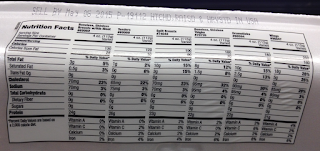We been down this road before, but this time it's going to be a bit bumpier.
A couple of years ago I criticized Panera Bread CEO Ron Shaich for the way he handled what we now call the "food stamp challenge." The intention with these efforts is always good – – bringing attention to the issue of food insecurity – – but almost invariably the people taking the challenge are so far removed from below-the-poverty-line conditions and so lacking in the necessary life skills that they make a complete hash of the attempt and end up misrepresenting the problem.
Shaich made errors largely of omission. Among other things, he skimped on high-protein foods that would've helped him stave off hunger. I am starting to feel a little bad about being so harsh in that case because I now see how much worse it could have been.
This Business Insider entry by Kathleen Elkins manages to demonstrate virtually every mistake you could make when trying to feed yourself on a tight budget, starting with where not to shop.
On Monday night I headed to the most affordable grocery store I could think of: Trader Joe's.As mentioned before, Trader Joe's is not a bargain grocery. The target demographic might be best described as budget-conscious foodie. If you're looking for imported, organic and (most importantly) prepared food, you will find some very reasonable options.
I was super conscious of sales as I wove through TJs, and the steals of the night included: sweet potatoes ($0.49 each), bananas ($0.19 each), and a 16-ounce bag of bowtie pasta ($0.99).
For the severely price-constrained, though, Trader Joe's shouldn't be your first or even second choice. Dried rice is only available in pricey varieties. Dried beans aren't available at all. Even the supposed "steals" of the night are available elsewhere at comparable or better prices.
But, even within the confines of this third-best choice, Many of Elkins' decisions were disastrous.
Red split lentils ($1.69)There are a few reasonable choices here -- the beans, the pasta, the bananas, the sweet potatoes -- but after that it gets ugly quickly. By my calculations and based on a couple of trips to Trader Joe's for research (with the caveat that some foods are cheaper in LA), more than half of Elkins' money went to purchases that were either bad or which could be replaced by much cheaper alternatives.
Bowtie pasta ($0.99)
Can of garbanzo beans ($0.89)
Can of black beans ($0.89)
Butternut squash soup ($2.79)
Chunky peanut butter ($2.49)
8 corn tortillas ($1.99)
Half-gallon of almond milk ($2.99)
Dozen organic eggs, since the only remaining non-organic eggs were cracked ($3.99)
8-pack of maple and brown sugar oatmeal ($2.99)
7 bananas ($1.33)
Bag of spinach ($1.99)
1 yellow onion ($0.79)
3 sweet potatoes ($1.47)
Sea salt ($0.99)
One of the biggest mistakes I made was not buying butter or oil, essential cooking ingredients that I take for granted and therefore completely overlooked.
You'll also notice there is no coffee, a staple in my normal diet but one that would blow the budget.
Elkins bought prepared food.
(You can make your own soup much cheaper and with less sodium)
She passed over frozen produce which was a fraction of the price of fresh.
She paid extra to make questionable nutritional choices. Keeping in mind that protein is our first priority and that a half gallon of milk costs $1.99 rather than $2.99, take a look at this:
Elkins would probably have been better off going for coffee instead of almond milk (she complained bitterly about caffeine withdrawal) and she would have had a dollar left over.
(Not the best deal on coffee, but certainly doable on the budget.)
Then there's $2.99 for an 8-pack of oatmeal. Here's how much oatmeal $2.50 gets me at the grocery store down the street.
Oatmeal is remarkably nutritious and a big bowl does an excellent job staving off hunger. At less than ten cents a serving, this is one of the places we want to indulge.
Even at Trader Joe's, Elkins could have done much better.
Like the oatmeal, the eggs Elkins bought are a good food at a very bad price. Non-organic are $1.99 at my Trader Joe's. That's a pretty good price per gram of protein but it's far from the best the store has to offer.
We're shooting for 50g a day. $4.00 worth of chicken goes a long way toward hitting that target. With a few other smarter choices (including more beans, more pasta, and, of course, no almond milk), she probably could have avoided the hunger pangs altogether.
Elkins' heart is in the right place and I appreciate her willingness to suffer for a story, but this is still bad and dangerous journalism. It misses the reality of poverty, it understates the effectiveness of an excellent program, and it can be more than a little insulting to those facing these challenges for real. Mary Elizabeth Williams put it best when writing about Gwyneth Paltrow’s SNAP Challenge for Salon:
And I’ve had an awful lot of conversations with people who think they’re being insightful when they declare that it turns out it’s really hard to get a job or to stretch a dollar. That it just can’t be done. Actually, guys, it’s hard for you to be poor. Lots of us are great at it. Lots of us do it every goddamn day.











No comments:
Post a Comment